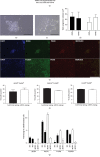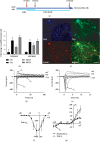Generation of Otic Lineages from Integration-Free Human-Induced Pluripotent Stem Cells Reprogrammed by mRNAs
- PMID: 32190057
- PMCID: PMC7068143
- DOI: 10.1155/2020/3692937
Generation of Otic Lineages from Integration-Free Human-Induced Pluripotent Stem Cells Reprogrammed by mRNAs
Abstract
Damage to the sensory hair cells and the spiral ganglion neurons of the cochlea leads to deafness. Induced pluripotent stem cells (iPSCs) are a promising tool to regenerate the cells in the inner ear that have been affected by pathology or have been lost. To facilitate the clinical application of iPSCs, the reprogramming process should minimize the risk of introducing undesired genetic alterations while conferring the cells the capacity to differentiate into the desired cell type. Currently, reprogramming induced by synthetic mRNAs is considered to be one of the safest ways of inducing pluripotency, as the transgenes are transiently delivered into the cells without integrating into the genome. In this study, we explore the ability of integration-free human-induced pluripotent cell lines that were reprogrammed by mRNAs, to differentiate into otic progenitors and, subsequently, into hair cell and neuronal lineages. hiPSC lines were induced to differentiate by culturing them in the presence of fibroblast growth factors 3 and 10 (FGF3 and FGF10). Progenitors were identified by quantitative microscopy, based on the coexpression of otic markers PAX8, PAX2, FOXG1, and SOX2. Otic epithelial progenitors (OEPs) and otic neuroprogenitors (ONPs) were purified and allowed to differentiate further into hair cell-like cells and neurons. Lineages were characterised by immunocytochemistry and electrophysiology. Neuronal cells showed inward Na+ (I Na) currents and outward (I k) and inward K+ (I K1) currents while hair cell-like cells had inward I K1 and outward delayed rectifier K+ currents, characteristic of developing hair cells. We conclude that human-induced pluripotent cell lines that have been reprogrammed using nonintegrating mRNAs are capable to differentiate into otic cell types.
Copyright © 2020 Sarah L. Boddy et al.
Conflict of interest statement
MNR is the founder of Rinri Therapeutics.
Figures



Similar articles
-
Differentiation and transplantation of human induced pluripotent stem cell-derived otic epithelial progenitors in mouse cochlea.Stem Cell Res Ther. 2018 Aug 29;9(1):230. doi: 10.1186/s13287-018-0967-1. Stem Cell Res Ther. 2018. PMID: 30157937 Free PMC article.
-
Modeling human early otic sensory cell development with induced pluripotent stem cells.PLoS One. 2018 Jun 14;13(6):e0198954. doi: 10.1371/journal.pone.0198954. eCollection 2018. PLoS One. 2018. PMID: 29902227 Free PMC article.
-
Critical roles of FGF, RA, and WNT signalling in the development of the human otic placode and subsequent lineages in a dish.Regen Ther. 2022 May 16;20:165-186. doi: 10.1016/j.reth.2022.04.008. eCollection 2022 Jun. Regen Ther. 2022. PMID: 35620640 Free PMC article.
-
Pluripotent stem cell-derived cochlear cells: a challenge in constant progress.Cell Mol Life Sci. 2019 Feb;76(4):627-635. doi: 10.1007/s00018-018-2950-5. Epub 2018 Oct 19. Cell Mol Life Sci. 2019. PMID: 30341460 Free PMC article. Review.
-
An Insight into DNA-free Reprogramming Approaches to Generate Integration-free Induced Pluripotent Stem Cells for Prospective Biomedical Applications.Stem Cell Rev Rep. 2019 Apr;15(2):286-313. doi: 10.1007/s12015-018-9861-6. Stem Cell Rev Rep. 2019. PMID: 30417242 Review.
Cited by
-
Exploring the application of stem cell technology in treating sensorineural hearing loss.Am J Stem Cells. 2024 Aug 25;13(4):212-221. doi: 10.62347/AEIV5813. eCollection 2024. Am J Stem Cells. 2024. PMID: 39308766 Free PMC article. Review.
-
Mechanism and Prevention of Spiral Ganglion Neuron Degeneration in the Cochlea.Front Cell Neurosci. 2022 Jan 5;15:814891. doi: 10.3389/fncel.2021.814891. eCollection 2021. Front Cell Neurosci. 2022. PMID: 35069120 Free PMC article. Review.
-
The Role of FoxG1 in the Inner Ear.Front Cell Dev Biol. 2020 Dec 3;8:614954. doi: 10.3389/fcell.2020.614954. eCollection 2020. Front Cell Dev Biol. 2020. PMID: 33344461 Free PMC article. Review.
-
Modern In Vitro Techniques for Modeling Hearing Loss.Bioengineering (Basel). 2024 Apr 26;11(5):425. doi: 10.3390/bioengineering11050425. Bioengineering (Basel). 2024. PMID: 38790292 Free PMC article. Review.
-
Application of Human Stem Cells to Model Genetic Sensorineural Hearing Loss and Meniere Disease.Cells. 2023 Mar 23;12(7):988. doi: 10.3390/cells12070988. Cells. 2023. PMID: 37048061 Free PMC article. Review.
References
Grants and funding
LinkOut - more resources
Full Text Sources

